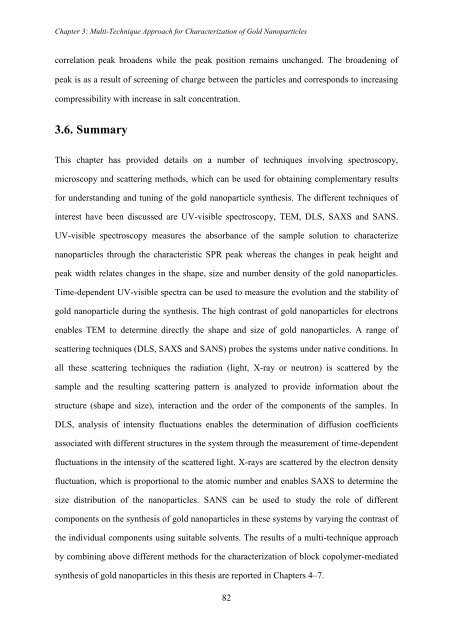PHYS01200704032 Debes Ray - Homi Bhabha National Institute
PHYS01200704032 Debes Ray - Homi Bhabha National Institute
PHYS01200704032 Debes Ray - Homi Bhabha National Institute
You also want an ePaper? Increase the reach of your titles
YUMPU automatically turns print PDFs into web optimized ePapers that Google loves.
Chapter 3: Multi-Technique Approach for Characterization of Gold Nanoparticles<br />
correlation peak broadens while the peak position remains unchanged. The broadening of<br />
peak is as a result of screening of charge between the particles and corresponds to increasing<br />
compressibility with increase in salt concentration.<br />
3.6. Summary<br />
This chapter has provided details on a number of techniques involving spectroscopy,<br />
microscopy and scattering methods, which can be used for obtaining complementary results<br />
for understanding and tuning of the gold nanoparticle synthesis. The different techniques of<br />
interest have been discussed are UV-visible spectroscopy, TEM, DLS, SAXS and SANS.<br />
UV-visible spectroscopy measures the absorbance of the sample solution to characterize<br />
nanoparticles through the characteristic SPR peak whereas the changes in peak height and<br />
peak width relates changes in the shape, size and number density of the gold nanoparticles.<br />
Time-dependent UV-visible spectra can be used to measure the evolution and the stability of<br />
gold nanoparticle during the synthesis. The high contrast of gold nanoparticles for electrons<br />
enables TEM to determine directly the shape and size of gold nanoparticles. A range of<br />
scattering techniques (DLS, SAXS and SANS) probes the systems under native conditions. In<br />
all these scattering techniques the radiation (light, X-ray or neutron) is scattered by the<br />
sample and the resulting scattering pattern is analyzed to provide information about the<br />
structure (shape and size), interaction and the order of the components of the samples. In<br />
DLS, analysis of intensity fluctuations enables the determination of diffusion coefficients<br />
associated with different structures in the system through the measurement of time-dependent<br />
fluctuations in the intensity of the scattered light. X-rays are scattered by the electron density<br />
fluctuation, which is proportional to the atomic number and enables SAXS to determine the<br />
size distribution of the nanoparticles. SANS can be used to study the role of different<br />
components on the synthesis of gold nanoparticles in these systems by varying the contrast of<br />
the individual components using suitable solvents. The results of a multi-technique approach<br />
by combining above different methods for the characterization of block copolymer-mediated<br />
synthesis of gold nanoparticles in this thesis are reported in Chapters 4–7.<br />
82

















